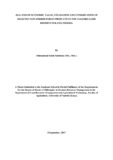| dc.description.abstract | The increasing degradation of non-timber forest resources due to anthropogenic activities and the growing impacts of climate variability and change call for a shift in the approaches of managing natural resources. Experts warn of imminent collapse of the forest ecosystems at current levels of degradation, which is mainly attributed to unsustainable management and utilization of natural resources. However, lack of data and absence of reliable information to guide formulation of appropriate policies for resource utilization and specifically conservation of non-timber forest products (NTFPs) is a major drawback in the efforts to ensure sustainable utilization of forest resources. In order to bridge the knowledge gap, this study analysed trends of forest cover change and the perceived drivers of forest resources degradation in the Falgore game reserve from 1985 – 2015, estimated the economic value of selected NTFPs from the FGR, determined the relative contributions of selected NTFPs to households’ income in the study area, and assessed the perceptions and attitudes of forest dependent communities towards protected area conservation approach. Multistage sampling technique was used to select 400 respondents for the study. Household interviews, focused group discussions and key informant interviews were used to elicit the prerequisite primary data in addition to the secondary information. Both inferential and descriptive statistics were used in data analysis.
The results of the spatio-temporal analysis of forest cover change in FGR shows that moderate woodland dominated in 1985 (46%) and 2005 (57%), but was replaced by open woodland in 2015, which now accounts for 58% of the total area of the forest. Dense woodlands occupied the least area of the forest and varied between 17% in 1985 and 1% in 2015. The results further indicate that dense woodland, moderate woodland, and very open woodland declined at an annual average rate of 3%, 1% and 0.4%, respectively. The main drivers of forest resource degradation in the area were found to be excessive fuelwood collection, poor grazing management, expansion of crop cultivation, harvesting of medicinal herbs and forest fires caused by illegal hunters and honey collectors. | en_US |



